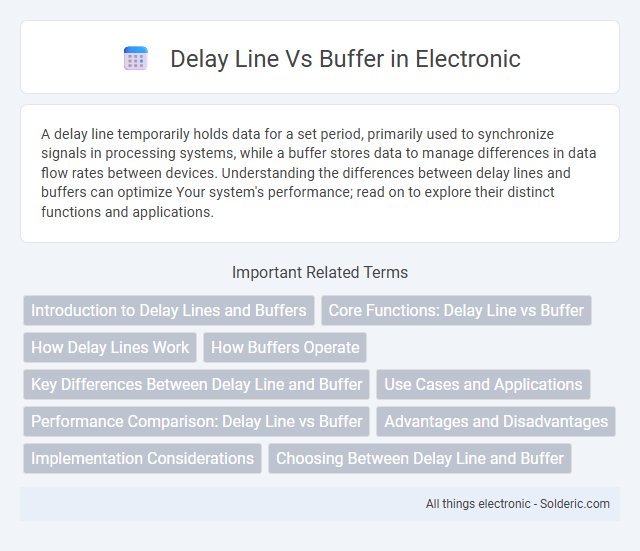A delay line temporarily holds data for a set period, primarily used to synchronize signals in processing systems, while a buffer stores data to manage differences in data flow rates between devices. Understanding the differences between delay lines and buffers can optimize Your system's performance; read on to explore their distinct functions and applications.
Comparison Table
| Feature | Delay Line | Buffer |
|---|---|---|
| Purpose | Introduces a controlled time delay to signals | Stores data temporarily for processing or transmission |
| Data Handling | Delays signal propagation without modification | Holds and manages variable data flow |
| Implementation | Analog or digital shift registers, acoustic or optical media | Memory units like RAM, FIFO queues, or registers |
| Use Cases | Signal synchronization, timing adjustments | Data smoothing, rate matching, temporary storage |
| Latency | Fixed and predictable delay | Variable delay depending on data input/output |
| Data Access | Sequential access only | Random or sequential access based on design |
Introduction to Delay Lines and Buffers
Delay lines store data temporarily by shifting information through sequential memory stages, primarily used in signal processing for precise time delays. Buffers act as intermediate memory storage to manage data flow between devices operating at different speeds, ensuring smooth and reliable data transfer. Both are essential in digital systems for timing control and synchronization, but delay lines emphasize time-shifting, while buffers focus on data rate adaptation.
Core Functions: Delay Line vs Buffer
A delay line temporarily holds data to introduce a specific time delay in signal processing, crucial for synchronization and timing adjustments. A buffer stores data to manage differences in processing rates between devices or stages, ensuring smooth data flow without loss. Your choice depends on whether precise timing (delay line) or rate matching and data integrity (buffer) is the primary requirement.
How Delay Lines Work
Delay lines operate by temporarily holding data for a specified period, allowing signals to be delayed in time without altering their content. They function through a series of storage elements, such as capacitors or shift registers, where data moves sequentially with each clock cycle until the desired delay is achieved. Unlike buffers that store and forward data immediately, delay lines precisely control timing by introducing a fixed latency in signal processing or communication systems.
How Buffers Operate
Buffers operate by temporarily storing data to manage differences in processing speeds between devices or system components, facilitating smooth data flow in computer architectures. They use memory or registers to hold incoming data until the receiving device is ready, minimizing data loss and ensuring synchronization. Unlike delay lines that rely on fixed physical delays, buffers provide flexible, controlled storage durations tailored to specific application requirements in digital systems.
Key Differences Between Delay Line and Buffer
A delay line stores data for a fixed time period, ensuring a precise delay before output, typically used in signal processing and telecommunications. A buffer temporarily holds data to manage differences in data flow rates between devices, preventing data loss or overflow in computing systems. Understanding these distinctions helps you select the appropriate method for data timing and flow management in your applications.
Use Cases and Applications
Delay lines are commonly used in signal processing for timing adjustments and synchronization tasks, especially in radar systems, audio effects, and telecommunications where precise timing control is crucial. Buffers are essential in computing and data communication to temporarily store data during transfer between devices or processes, preventing data loss and managing differences in processing speeds. Your choice depends on whether you need to manipulate signal timing or manage data flow efficiently.
Performance Comparison: Delay Line vs Buffer
Delay lines and buffers both serve as temporary storage in signal processing, but delay lines excel in maintaining signal timing with minimal latency, crucial for real-time audio and communication systems. Buffers are designed to manage data flow between processes with varying speeds, often introducing more latency due to data accumulation and processing overhead. Your system's performance depends on choosing delay lines for precise timing needs and buffers for smoother data handling under variable processing rates.
Advantages and Disadvantages
Delay lines offer precise timing control by storing signals for fixed periods, making them ideal for applications requiring synchronized signal processing, but they can introduce latency and are less flexible for variable delays. Buffers provide temporary data storage that helps manage data flow and prevent overruns in communication systems, offering greater adaptability for varying data rates but potentially increasing complexity and power consumption. Choosing between delay lines and buffers depends on the balance between required timing precision and system flexibility.
Implementation Considerations
Delay lines are often implemented using shift registers or chains of flip-flops for precise timing control, making them suitable for applications requiring fixed, short delays. Buffers utilize memory arrays like RAM or FIFO structures to manage variable-length data storage and retrieval, providing flexibility in handling data flow and synchronization. Choosing between delay lines and buffers depends on factors such as required delay precision, data volume, and system resource constraints in digital signal processing or communication systems.
Choosing Between Delay Line and Buffer
Choosing between a delay line and a buffer depends on the specific needs of signal processing or data management tasks. Delay lines are ideal for timing adjustments and echo effects, providing controlled signal delay without altering data integrity. Buffers excel in managing data flow and temporary storage, ensuring smooth processing by compensating for speed mismatches between systems or components.
delay line vs buffer Infographic

 solderic.com
solderic.com